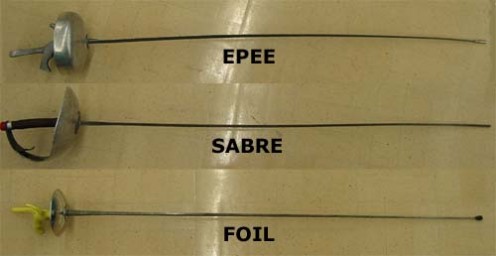

Cut (Coup de taille) an attack made with a chopping motion of the blade, landing with the edge or point. Cross (Passe avant, passe arrière) an advance or retreat by crossing one leg over the other also passe' avant (forward cross), passe' arriere (backwards cross). Croisé also semi-bind an action in which the opponent's blade is forced into the high or low line on the same side. Coupé also cut-over an attack or deception that passes around the opponent's tip. Valid for normal halts, but not valid at end of time. Coup lancé Coup déjà lancé a launched hit an attack that starts before a stop in play but lands after.

Coulé also graze, glise', or glissade an attack or feint that slides along the opponent's blade. Counter-time (Contre-temps) an attack that responds to the opponent's counter- attack, typically a riposte following the parry of the counter-attack. Counter-riposte (Contre-riposte) an attack that follows a parry of the opponent's riposte. the defender first comes around to the opposite side of the opponent's blade. Counter-parry (Contre-parade) a parry made in the opposite line to the attack ie. Counter-disengage (Contre-dégagement) a disengage in the opposite direction, to deceive the counter-parry. Counter-attack (Contre-attaque) an attack made against the right-of-way, or in response to the opponent's attack. "body-to-body" physical contact between the two fencers during a bout, illegal in foil and sabre.

Conversation the back-and-forth play of the blades in a fencing match, composed of phrases ((phrases d'armes) punctuated by gaps of no blade action. Compound (Attaque composée ou parade composée) also composed an attack or riposte incorporating one or more feints to the opposite line that the action finishes in. Change of Engagement (Changement d'engagement) engagement of the opponent's blade in the opposite line. Button (Mouche Bouton) the safety tip on the end of practice swords. Broken Time (Changement de Rythme) a sudden change in the tempo of one fencer's actions, used to fool the opponent into responding at the wrong time. Broadsword (Estramaçon) a military sword and fencing weapon popular in the 18th-19th centuries, similar to a heavy sabre any straight-bladed, double- edged, single- handed cutting sword of the post-medieval period. Bout (Match) an assault at which the score is kept. The offending fencer is usually expelled from the event or tournament. Black Card (Carton noir) used to indicate the most serious offences in a fencing competition. Bind (Liement) an action in which the opponent's blade is forced into the diagonally opposite line. Beat (Battement) an attempt to knock the opponent's blade aside or out of line by using one's foible or middle against the opponent's foible. Bayonet (Connecteur à baïonnette) a type of electrical connector for weapons.

Balestra (Balestra) a forward hop or jump, typically followed by an attack such as a lunge or fleche. Attack au Fer an attack that is prepared by deflecting the opponent's blade, e.g., beat, froissement, pressure. Attack (Attaque) the initial offensive action made by extending the sword arm and continuously threatening the valid target of the opponent. Assault (Assaut, Combat) friendly combat between two fencers. Aids (Aides) the last three fingers of the sword hand. Advance (Marche) a movement forward by step, cross, or balestra. Absence of blade (Absence de fer) when the blades are not touching opposite of engagement.


 0 kommentar(er)
0 kommentar(er)
